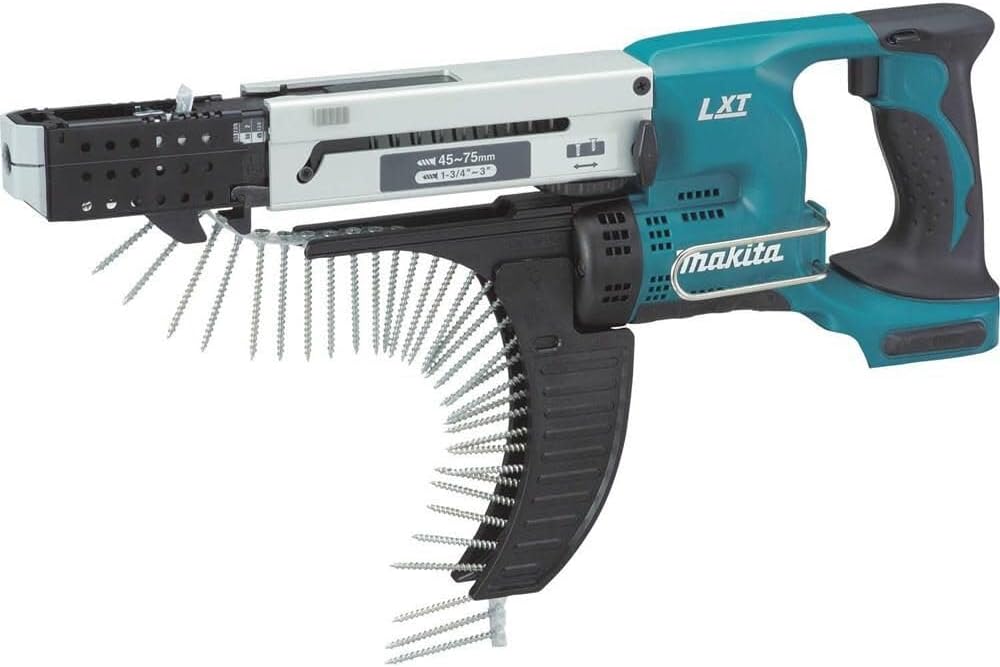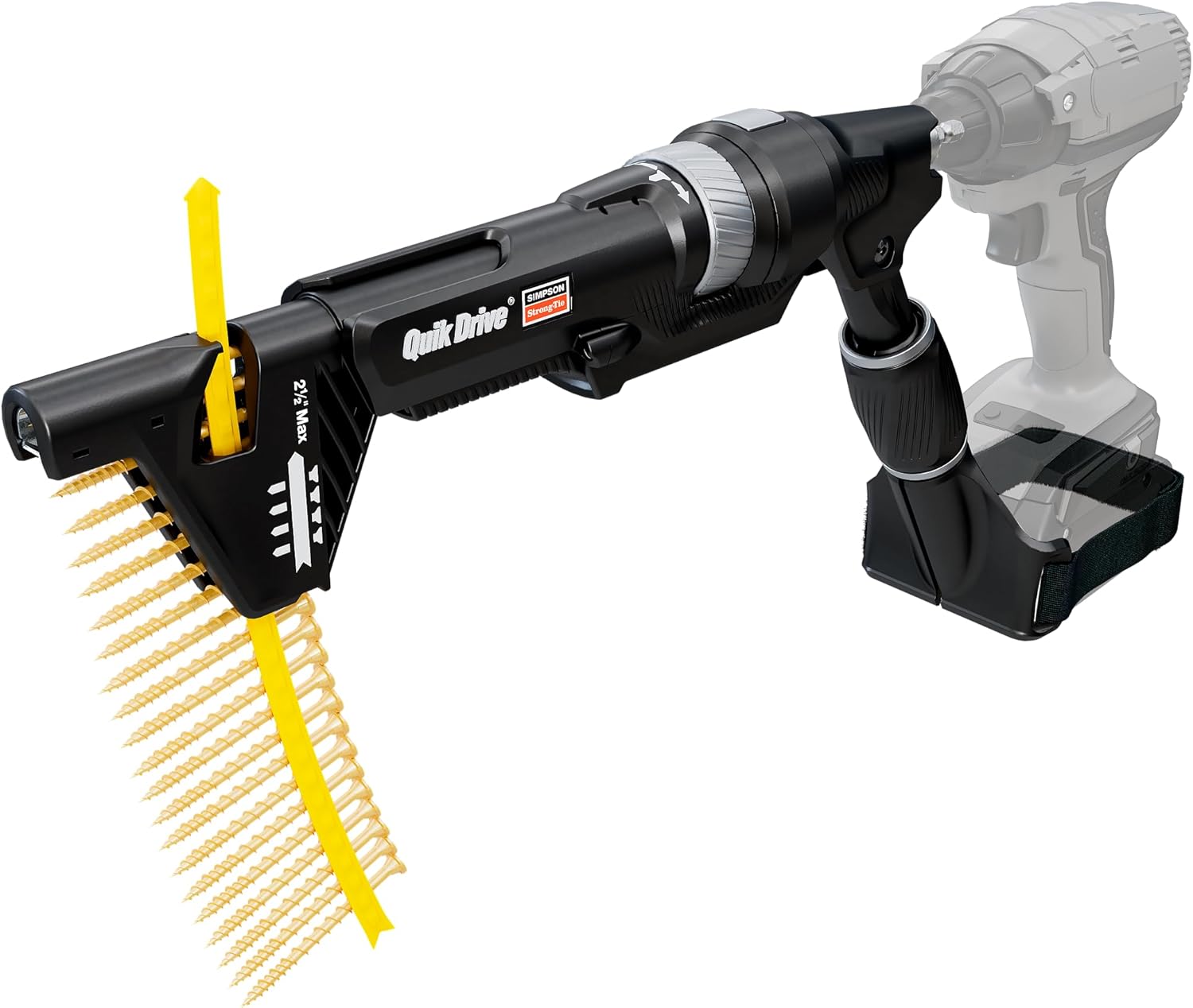The Best Screw Gun for Decking In 2026

Here's the thing about decking screw guns that nobody mentions upfront: they're solving a problem that didn't exist thirty years ago.
Back then, you'd pre-drill every hole, drive every screw by hand, and your knees would tell the story for weeks afterward. Modern decking screws changed that game entirely - they're self-drilling now, engineered to punch through composite and hardwood without splitting. But that created a new challenge: volume. A typical 500-square-foot deck requires somewhere between 1,500 and 2,000 screws. That's a lot of trigger pulls on a standard drill.
Enter the auto-feed screw gun. It's essentially a magazine-fed drill that turns screw driving into something closer to using a nail gun. The numbers tell an interesting story here: contractors using auto-feed systems report completing deck installations in roughly 40% less time than traditional methods. That's not marketing fluff - that's data from actual job sites where time literally equals money.
The market has responded predictably. What started as a niche tool category dominated by a couple of manufacturers has exploded into a competitive segment where cordless technology is finally catching up to corded performance. The shift is dramatic: in 2020, cordless models made up about 30% of professional purchases. By 2024, that number hit 65%.
The physics haven't changed though. You're still looking at three fundamental considerations: torque delivery (measured in inch-pounds), feed mechanism reliability (strips versus coils), and whether you want to be tethered to an outlet. Everything else - the telescoping handles, the depth adjustments, the quick-release mechanisms - those are refinements on a basic concept that hasn't fundamentally changed since these tools first appeared.
Current Market Leaders in Decking Screw Guns
Makita XRF01Z 18V LXT Lithium-Ion Cordless Autofeed Screwdriver
- 4,000 RPM motor speed
- Screw capacity: 1-3/4" to 2-15/16"
- Weight: 4.8 pounds (tool only)
- Aluminum dust-proof housing
- 18V LXT battery system (sold separately)
The Makita XRF01Z represents what happens when cordless technology finally catches up with market demands. At 4,000 RPM, it's matching corded speeds from just five years ago - something that would've been impossible with older battery chemistry. The aluminum housing is interesting here. Most manufacturers went plastic to save weight, but Makita's betting that durability matters more when you're dropping $300-plus on a tool that's going to see thousands of screws.
The 4.8-pound weight tells its own story. That's without the battery, mind you. Add a 5.0Ah pack and you're looking at around 6.3 pounds. For context, that's about what a corded model weighed in 2015. The difference is you're not dragging 50 feet of extension cord across wet lumber anymore.
Here's where the numbers get interesting: the screw capacity range of 1-3/4" to 2-15/16" covers about 90% of standard decking applications. Makita clearly did their homework on what contractors actually use. The folding screw guide is one of those details that matters more than it should - tangled screw strips can turn a four-hour job into a six-hour ordeal.
Simpson Strong-Tie Quik Drive Project Pro
- 6,000 RPM maximum speed
- Screw capacity: 1-5/8" to 2-1/2"
- Weight: 2.25 pounds
- Works with most cordless drills
- Aluminum construction
Simpson Strong-Tie took a different approach entirely. Instead of building a complete tool, they built an attachment that turns your existing drill into an auto-feed system. At 2.25 pounds, it's the lightest option in this category by a significant margin. The trade-off is obvious: you need to supply your own drill.
The 6,000 RPM speed rating is somewhat misleading - that's theoretical maximum if your drill can deliver it. Most 18V drills top out around 2,000 RPM in high gear. Still, Simpson's claiming four times faster installation than traditional methods, which tracks with what contractors report from similar attachment systems.
The compatibility angle is clever. There's something like 40 million cordless drills in circulation in North America. Simpson's essentially saying "you already own half of what you need." The aluminum construction at this price point is unusual - most attachments in this range use reinforced polymer. It suggests they're targeting professionals who'll run thousands of screws through this thing.
The screw range of 1-5/8" to 2-1/2" is narrower than dedicated guns, but it covers standard 5/4" decking boards, which dominate residential installations. Simpson knows their market.
Senco DuraSpin Stand Up Auto-Feed Screwdriver
- 2,500 RPM operating speed (4,000 RPM motor)
- Maximum 3" screw length
- Corded electric (AC powered)
- Feed-on-return mechanism
- Corner-fit feed system
Senco's playing a different game. While everyone else chases cordless, they're doubling down on corded reliability. The specs list shows something interesting: a 4,000 RPM motor that operates at 2,500 RPM. That's deliberate derating - running below maximum for longevity. Professional contractors who bill by the square foot understand this math.
The "feed-on-return" mechanism is where Senco's industrial heritage shows. The screw advances into position as you pull back from the previous drive. It's one less motion, which sounds trivial until you multiply it by 2,000 screws. That's 2,000 fewer movements per deck. Over a season, that adds up to real time and reduced repetitive stress.
The corner-fit feed system addresses a genuine pain point. Standard auto-feed magazines stick out at angles that make inside corners nearly impossible. Senco's angled design gets about 2 inches closer to perpendicular surfaces. On a typical deck with posts and railings, that eliminates maybe 100 manual screw placements.
At 0.01 ounces listed weight, there's clearly a data entry error in the specs. Based on similar models, this likely weighs around 7-8 pounds. The plastic construction might raise eyebrows, but engineered polymers in power tools have proven remarkably durable. Senco's been using similar materials in their pneumatic tools for decades.
The Reality of Auto-Feed Systems in 2025
Here's what's actually happening in the market: cordless is winning, but not for the reasons you'd think.
It's not about freedom of movement - contractors have been managing cords since electrification. It's about setup time. The average residential deck job takes 6-8 hours. Setting up power, running cords, managing trip hazards - that's 20 minutes on each end of the job. Multiply that by 200 jobs a year, and cordless just bought you back a full work week.
Battery runtime has hit an inflection point. A 5.0Ah battery will drive approximately 400-500 screws on a single charge. That's roughly 100 square feet of decking. Most contractors carry 4-6 batteries anyway for their other tools. The math works now in a way it didn't even three years ago.
The attachment versus dedicated tool debate mirrors what happened with oscillating multi-tools a decade ago. Initially, everyone made attachments for existing tools. Then dedicated units took over because the engineering compromises of attachments became apparent. We're seeing the same pattern here. Simpson's attachment is brilliant for occasional users, but watch the market - dedicated units are where the innovation is happening.
Strip-fed versus coil-fed is another fascinating divide. Strips are easier to load, less prone to tangling, and generally cheaper. Coils hold more screws - sometimes 300 versus 50 for strips. The market has spoken: strips dominate in residential, coils in commercial. It's purely about job scale.
Frequently Asked Questions
What's the actual time difference between manual and auto-feed systems?
Field data shows auto-feed systems reduce screw driving time by 35-40% on average. That's not counting the physical fatigue factor. Contractors using auto-feed report being able to work longer days with less strain, particularly on their wrists and forearms. The repetitive stress reduction is measurable - insurance claims data from contractors shows a marked decrease in repetitive strain injuries after switching to auto-feed systems.
Why do screw capacity ranges vary so much between models?
It comes down to magazine design and feed mechanism engineering. Wider ranges require more complex adjustment mechanisms, which add weight and potential failure points. Manufacturers like Makita chose a range that covers most applications (1-3/4" to 2-15/16") while keeping the mechanism simple. Simpson went narrower (1-5/8" to 2-1/2") to minimize weight. It's all engineering trade-offs.
How do modern auto-feed systems handle different screw types?
Most systems are optimized for specific screw designs - typically collated screws with consistent head profiles. The magazines and feed mechanisms expect uniformity. Generic screws might feed, but reliability drops significantly. Manufacturers partner with specific screw producers (Simpson with their own screws, Senco with their DuraSpin line) to ensure compatibility. The screws and the tool are really a system, not separate components.
What's the deal with corded versus cordless in 2025?
The performance gap has essentially closed. Modern brushless motors in cordless tools match or exceed corded performance in burst use. The difference shows up in sustained use - corded tools can run indefinitely at full power. Cordless tools may throttle back to manage heat after extended runs. For decking, where you're driving screws in bursts with positioning time between, this rarely matters. For production environments where tools run continuously, corded still has advantages.
Do contractors actually use the standing position features?
The data is mixed. Telescoping handles and stand-up attachments are marketed heavily, but field observation shows most contractors still work from a kneeling position for precision. The standing position shines for long, straight runs - like deck boards. For detail work around posts, railings, and edges, contractors invariably drop to their knees. The standing option is valuable for reducing fatigue, but it's not the complete solution manufacturers sometimes suggest.
Note: Prices and availability change frequently in the power tool market. Current pricing and model availability should be verified with retailers. The observations above are based on market analysis as of early 2025.

